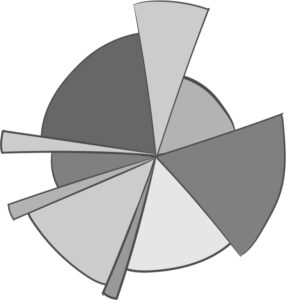New projects make work invigorating and it’s fun building things we care about. When we’re all able to do so much more with less in our connected era, the danger becomes how easy it is to spread yourself too thin. If you seek to unlock the boundless energy from a balanced career portfolio, it’s critical to keep an eye on your personal bandwidth.
 To make it easy, visualize all the work you do as a dynamic pie chart. Each project you’re involved with represents one slice. It’s not an exact science, but the more time, money and energy you spend on something, the larger that slice becomes. Let’s call this your career portfolio.
To make it easy, visualize all the work you do as a dynamic pie chart. Each project you’re involved with represents one slice. It’s not an exact science, but the more time, money and energy you spend on something, the larger that slice becomes. Let’s call this your career portfolio.
Most of us can manage multiple slices of activity within our career portfolio. For example, a traditional, salaried position may be the lion share, but there’s still room for that innovative idea at your company, a little side hustle, the volunteer role and mentoring a few other entrepreneurs. No matter what makes up the complete pie chart, stay mindful of the coevolving sizes of each slice and how everything interacts within the overall system.
Saying yes or no to new projects should obviously be carefully considered. As you make these decisions, be honest with the resources required to continue building on each front. The time you spend on one thing can’t be spent on others, but positive force in one area often fuels fresh energy (and clarity if it’s time to quit) for other areas of your career portfolio. When different projects are in the same realm, synergies may be easier to compound, but sometimes having projects in completely different industries provides stabilizing diversification.
Beyond the obvious impact of adding or removing elements within your career portfolio, how resources are spent on existing areas of your career portfolio should feel strategic. Think about how much time is being spent compared to the income that’s being produced. There are other factors to consider too, as we know it’s not all about the money. Reflect on the type of energy each project generates. Who do you get to work with and how does the work make you feel overall? Hobbies that pay just enough to break even, leading a group of people you care about or volunteering to become a mentor are all wonderful examples of satisfying additions that don’t pay the bills.
Have something that’s dragging you in the wrong direction? It’s hard to revive old projects, but don’t be afraid to put things on the back burner. That said, if it is time to quit, read The Dip by Seth Godin, then decide if and when to make your move. Winners quit all the time, they just quit the right things at the right time.
That last sentence reveals one more important variable: good timing. When you activate new projects, adjust resources or quit something to make space for what’s next, good timing will provide a noticeable blend of confidence and tranquility. This state of mind will allow your work to make a bigger impact. To give yourself room to find good timing, remember entrepreneurship is not a race. Urgency is helpful because it creates valuable momentum, but stay patient knowing that persistence is the ultimate wild card.
Extra Shot
I once had a boss tell me I could never catch two rabbits. That’s outdated. With a balanced career portfolio and the support of those around you, we’re all able to catch more proverbial rabbits without diluting ourselves to mediocrity. Learn to efficiently activate different energies, on different projects, with different people, at different times, that all connect through you.
